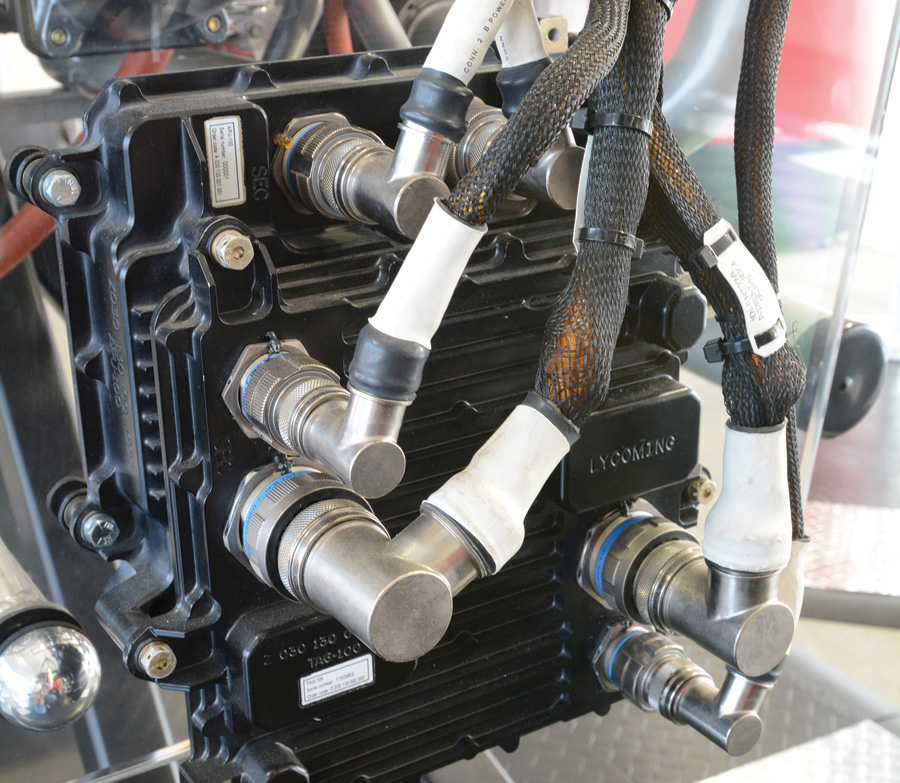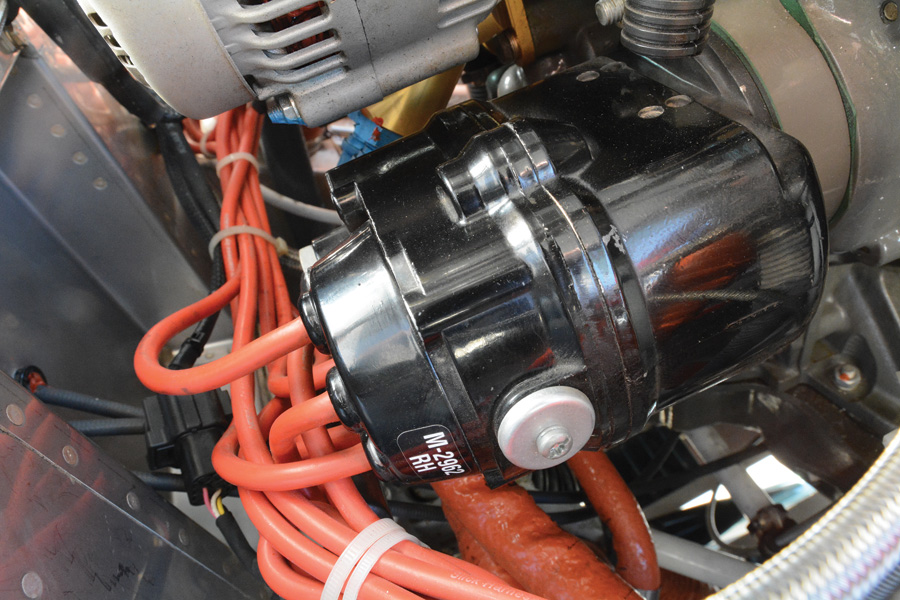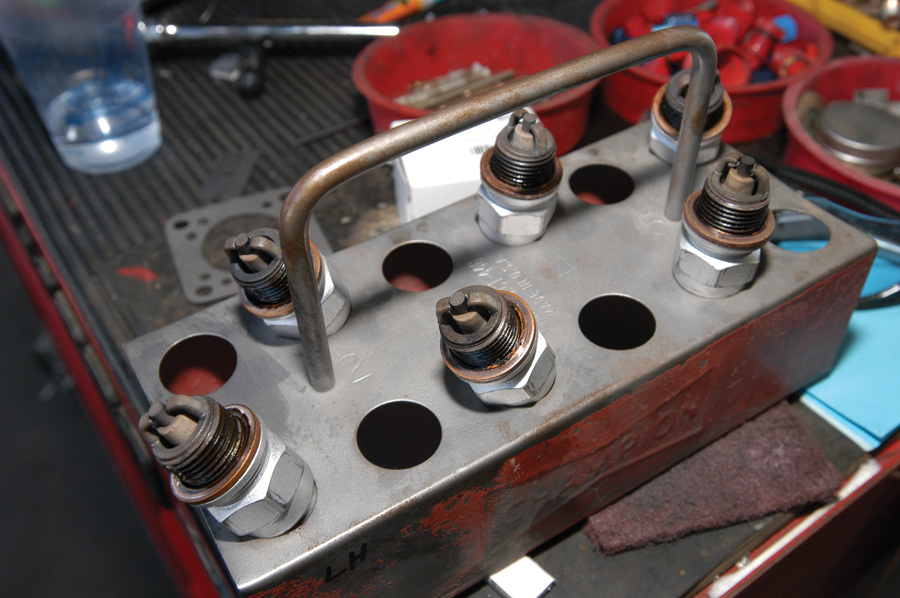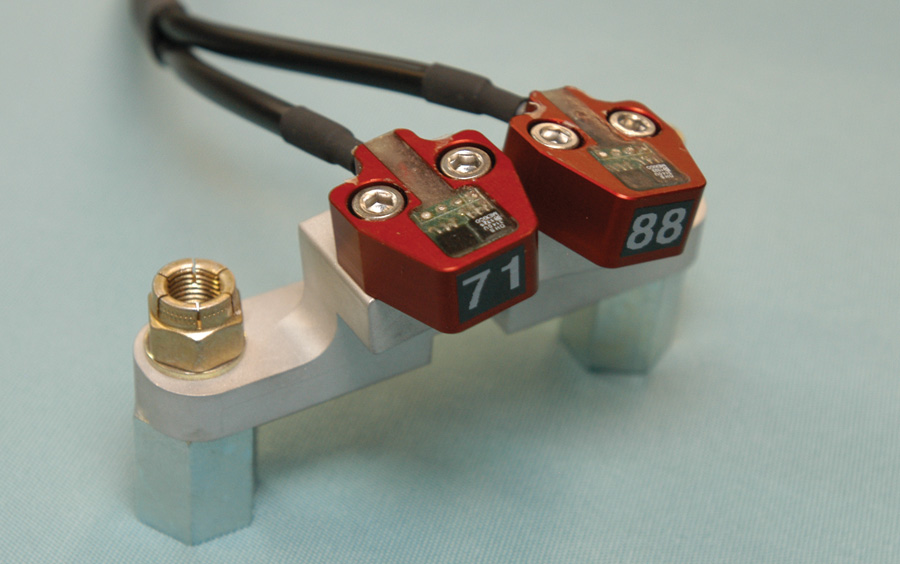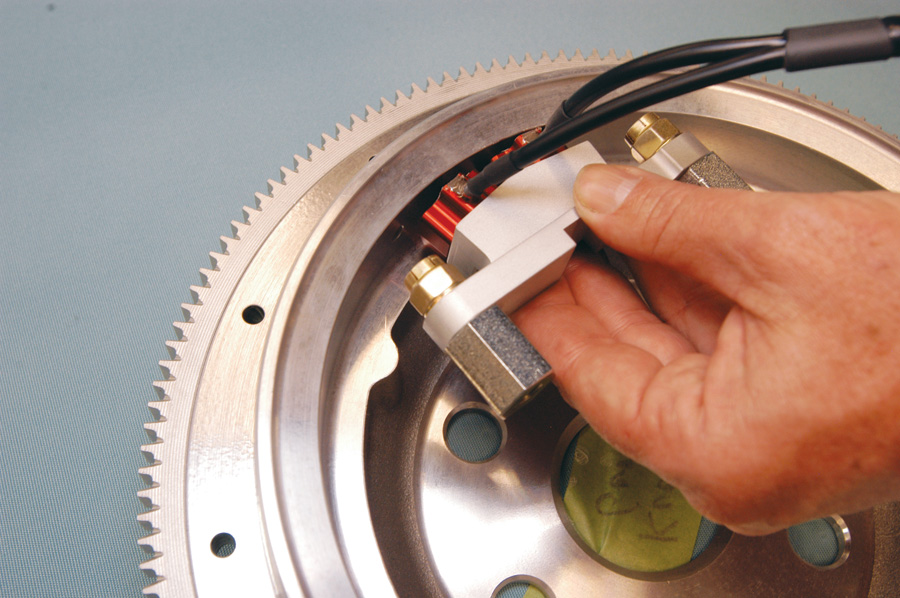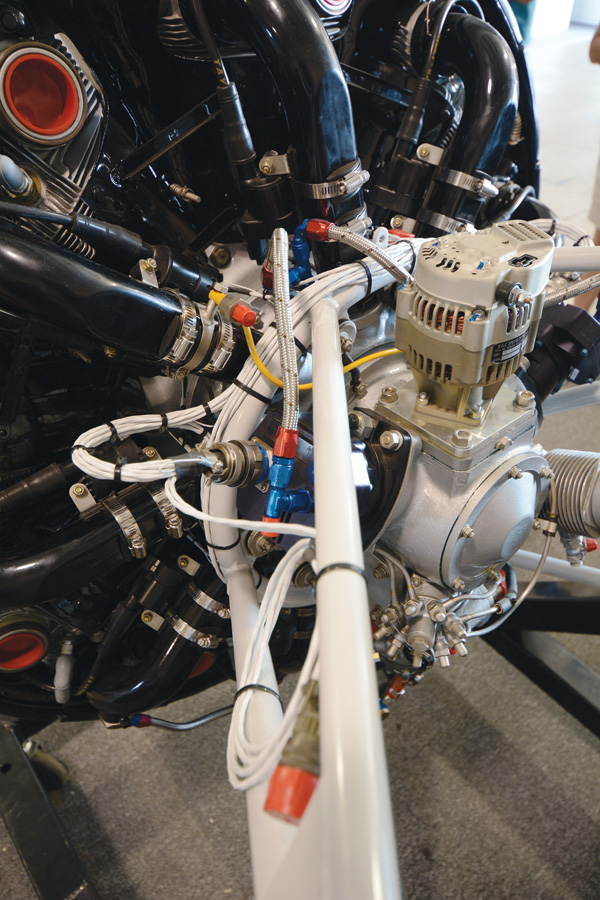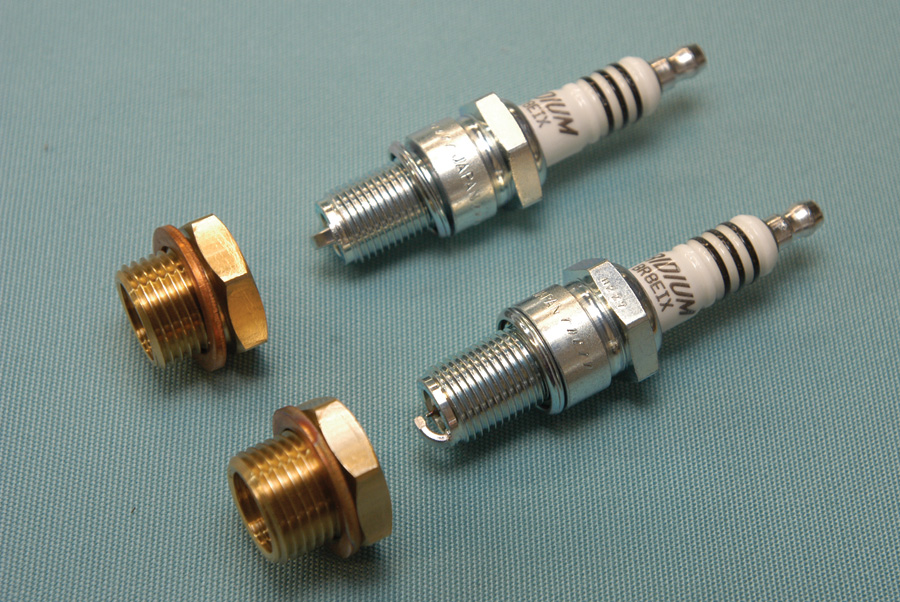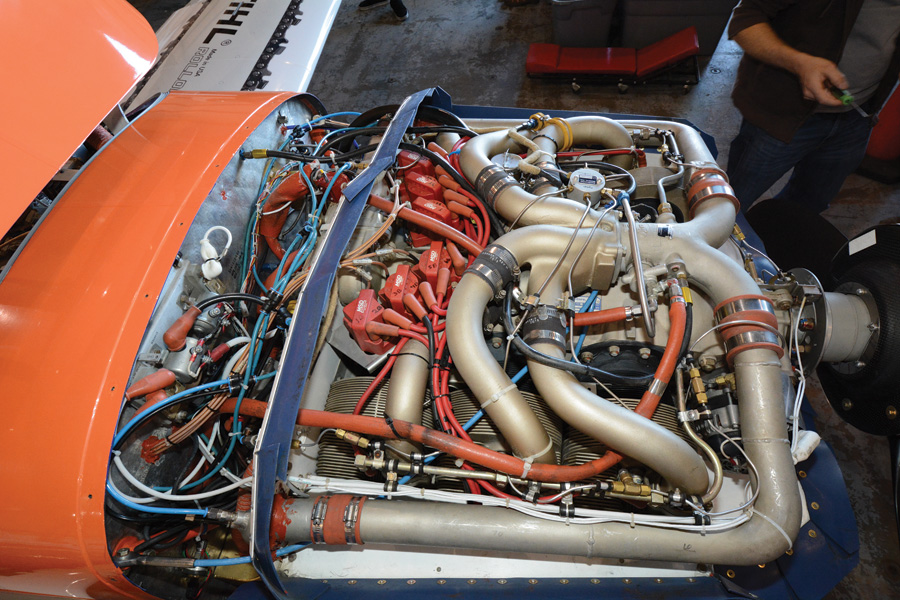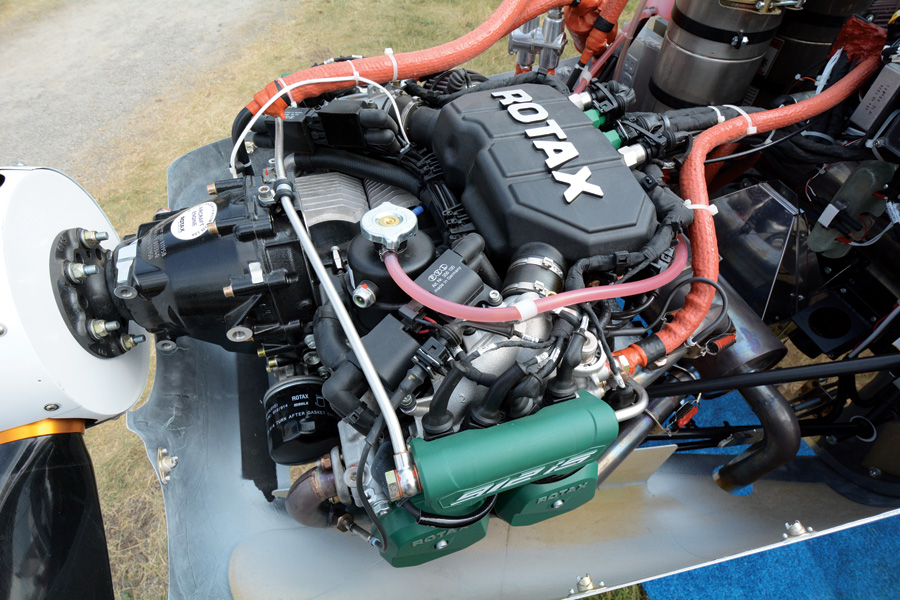High-end original-equipment engine management systems, such as this Lycoming display engine, use aerospace-grade connectors. They’re bulletproof, but another reason why such systems are expensive.
In case you missed the fire triangle in school, it takes three things to appear concurrently in the combustion chamber of your engine to light the fire that makes our airplanes go. In this on-going series of articles we’ve already discussed two legs of that triangle, fuel and air, and now we’re going to address the third and weakest leg, ignition.
Small Balls of Fire
Magneto-based ignition systems have been the aviation ignition standard since the Wright brothers, with various forms of electronic ignition getting into the game in the last 30 years or so. But no matter what the source of ignition, what they actually do in the combustion chamber has been the same: ignite a flame kernel.
Self-energizing, compact, and mechanical, magneto ignition has served aviation for over a century. Still a passable choice for simple, low-altitude flyers, magneto ignition’s lack of advance/retard capability, low spark energy at starting rpm, and inability to integrate into a digital control system are its main limitations.
Consider the environment inside the combustion chamber an instant before the spark plug fires. A roiling mass of air and fuel is being squeezed ever tighter by the rising piston. Even in a correctly running cylinder, some of that fuel is still in minute liquid droplets; it’s too wet and oxygen starved to burn. Other areas are still plain air, devoid of fuel and thus also unable to burn. Much of the air/fuel charge in the cylinder is obviously in between these fuel rich and fuel lean extremes and can support combustion, but even so, much of the ignitable charge is a bit rich and might ignite on its surface where it adjoins leaner air, but by itself is too wet to support continued combustion. It might ignite, but then extinguish just as quickly. Similarly, some of the mixture is quite fuel lean, and while it also might ignite if in close proximity to the spark plug gap, it too will flame out due to a lack of fuel.
Also consider these varying pockets of rich and lean mixtures are moving as part of the in-cylinder motion of the air/fuel charge. So, when a spark does jump the gap between the spark plug’s electrodes, there’s a fair chance it might not ignite anything because the spark encountered too rich or too lean mixtures, or it might start a bit of mixture on fire, but have it blow out so quickly the rest of the mixture doesn’t ignite. In all such cases the cylinder misfires.
Misfiring is more common than thought and is an obvious party pooper. It’s hard on fuel efficiency as you can imagine, and also a horrid mess from an emissions standpoint—all those raw and partially burned hydrocarbons spew into the atmosphere. It’s no surprise that curing misfiring has been a holy grail of automotive engineers in their quest to meet ever-tightening emission and fuel economy regulations.
Typical dual/massive-electrode aviation spark plugs are mainly about durability. It’s also commonly assumed that aviation engines fit two spark plugs per cylinder for redundancy, but the main reason is performance. Try switching to one magneto while cruising to see how much rpm is lost. At over 5-inches in diameter, large-bore Continentals and Lycomings need plugs on each side of the cylinder to burn all the mixture in the time allotted.
A typical 1970’s carbureted engine with then conventional points-type battery ignition misfired about seven percent of the time under normal conditions. Misfiring below approximately 10 percent is imperceptible to even sensitive drivers, with much of the general public unable to sense misfiring until it reaches even 25 percent during lightly loaded cruise conditions. Presumably aircraft engines, with their twin spark plugs, are less likely to misfire; we haven’t seen data on the subject.
It also becomes clear that what the ignition system really does is ignite a flame kernel, a small ball of burning mixture adjacent to the spark plug gap. And it’s the successful flame kernel, one that keeps burning long enough to raise the temperature of the mixture around it, which torches the rest of the charge in the combustion chamber. So, the ignition system has to start the flame kernel, but once the flame kernel is burning, the ignition system is no longer a factor.
Induction
A bit of physics before we get to the hardware: It’s a property of electromagnetism (Faraday’s Law) that if a magnet and a coil of wire are passed by each other, an electric current is induced in the wire. The faster the two pass each other, the greater the voltage produced. It’s this induction of electrical current that’s at the heart of generators, alternators, magnetos, and ignition coils.
The same induction of electrical energy can be generated using an electromagnet—two coils of wire, one with electricity flowing through it, is the essence of an electromagnet. Collapse the magnetic field by shutting off the electricity, and electricity is induced in the second wire winding.
The major difference between using a permanent magnet versus an electromagnet is the electromagnet must have an outside source of electricity to induce voltage in the second wire coil. The similarity is the electromagnet mimics the motion of the permanent magnet (the motion is necessary to induce the voltage) when the outside source of electricity is switched off. Like the permanent magnet system, the electromagnet makes more current flow the faster the outside electric source is switched on and off, and in proportion to the amount of magnetic flux present in the first place.
So, why the monkey motion with these wire coils? It’s to raise the induced current’s voltage. That’s done by having relatively few windings of wire in the coil’s first winding and many, many turns of wire in the second winding. This acts like an electric gear ratio: battery voltage goes in and anywhere from 5,000 to over 15,000 volts come out. The high voltage is necessary to jump the gap between the spark plug’s electrodes.
Key technology to electronic ignition is a solid-state triggering mechanism to time the ignition events. Typically this means a magnetic pickup that senses a magnet passing by to produce an on/off, “square wave” signal. Here an EFii flywheel trigger magnet is being pointed out.
Magneto Ignition
A magneto is an assembly of a permanent magnet electrical generator that passes the electricity it generates to a coil. The coil is actually our two coils of wire, one inside the other. The first winding in the coil is electrically energized by the generator. That electricity is switched on and off by a mechanical switch called “the points” because it contains a pair of electrical contacts, or points. The on-off current flow in the first set of windings induces high-voltage electricity in the coil’s second winding. The juice induced in the coil’s second winding is then shuttled to the correct spark plug by the distributor section of the magneto, thus causing a spark when the electricity jumps the spark plug’s gap.
One magnetic pickup is needed per ignition system, and automotive systems use just one sensor. But for dual redundant aviation systems, as in this EFii example, two sensors are used to trigger two separate electronic control units (computers).
While a magnetic pickup can work on any rotating assembly the engine offers, reading the crankshaft is most accurate. On Lycs and Continentals this invariably means mounting the sensors rigidly to the engine case and quite close to the magnets in the starter flywheel.
Magneto ignition boasts two impressive advantages: it’s simple with a minimum of failure points, and it’s self-contained. No outside energy is needed, such as from an alternator or battery. In fact, the aircraft doesn’t need an electrical system. As long as the engine, and thus the magneto, is rotating, the mag is bound to be producing sparks at the plugs. In practice, this inherent reliability is backed by having two magnetos operating separate sets of spark plugs.
Magneto ignition limitations are numerous. One issue is spark energy builds with rpm. There isn’t much amperage (mass) and voltage (pressure) in magneto output unless the mag is turning cruise rpm. Thus, starting and idling an engine with a magneto can be a little iffy or result in relatively high misfiring.
The adequate, but not generous spark energy from a compact, aviation-style magneto is also a limit when trying to jump large spark plug gaps or fire sketchy air/fuel mixtures resulting from thin air densities at altitude or inexpert mixture management by the pilot.
Electronic ignition and improved fuel injection are transportable to just about any engine with pistons. Barrett Precision Engines developed their own e-ignition for the Vedeneyev M14P radial, along with a single-nozzle version of Bendix fuel injection, as part of an electro-mechanical modernization campaign that netted approximately 40 more horsepower.
It’s also mechanically inopportune to provide ignition timing advance or retard with a magneto (P-Mag manages the trick electronically). Yes, the general magneto timing relative to the engine crankshaft is ground adjustable by an A&P technician, but after that, the timing is fixed. It does not vary with engine rpm (luckily for magnetos, airplane engines run in very narrow rpm ranges) or other conditions, namely how much the engine is loaded (think manifold pressure). This is a major limitation in aircraft as the fuel mixture and charge density varies with pilot input and altitude. Much power and efficiency is wasted by fixed ignition timing.
Magnetos are also fairly heavy, and as mechanical devices they wear and require occasional maintenance. Thus, the need to check the ignition timing during a condition inspection, along with magneto overhauls each 500 hours of operation.
Battery Ignition
If you remove the generator section of a magneto and substitute an alternator/battery combination to power the coil, you have the basics of battery ignition. Cars have been running battery ignitions for ages, but note battery ignition can be either a simple electric circuit with mechanical triggering (points) or use solid-state triggers such as Hall effect sensors. When solid-state parts are used the “electronic ignition” label is applied.
Assuming the vehicle already has an alternator and battery, a battery ignition weighs less than a magneto. More importantly, it can output a consistently hot spark regardless of engine rpm, and certainly not least, the timing can be easily advanced or retarded.
Most aftermarket ignition systems use commercially available connectors in their sensor network. This is a major cost containment strategy and reports of connector failure are rare.
Capacitive Discharge
One limitation to magneto and battery ignitions is it takes time to saturate the coil—build a magnetic field and collapse it. This limits spark energy at high rpm, especially as the engine gains cylinders. A capacitor is a near instant-acting electrical storage device; it is much faster to gain and discharge electricity than a coil, so by replacing a single coil with a capacitor, eye-watering rpm in multi-cylinder engines is easily accommodated.
Furthermore, a capacitor can be highly charged by the electrical system so the spark energy is typically very powerful. The capacitor’s blinding speed is also its issue because the spark duration, while very “hot,” is very short. Typically this is countered by having multiple sparks per ignition event, especially at lower engine rpm. Also, CD ignition parts miniaturize well, making them near universal on smaller engines, such as chain saws, motorcycles and ultralights. The very popular Light Speed Engineering Plasma ignitions are CD units and are the lightest weight method of sparking Experimental Lycs and Continentals.
Low Tension, High Tension
One way to enable a hot, long-duration spark with magnetos and battery ignitions is to switch from a single coil for all cylinders (high tension system) and put one coil at each spark plug (low tension). This greatly lengthens the time for each coil to saturate, plus the major length of the wiring to the spark plugs need carry only low-voltage electricity. That reduces electrical losses at high altitudes or with high-energy ignitions and is why low-tension magneto ignition was the norm on big, high-flying radials during the big-engine peak of the 1940s and ’50s. It’s also the norm on modern automobiles where powerful coil-on-plug ignitions are used to reliably light very lean mixtures.
High-tension magneto systems are the norm in sport aviation, but low-tension Bendix 600 and 700 series magneto systems are not unknown in higher-output Lycomings (and a few antediluvian Continentals). Contemporary FADEC systems from both Lycoming and Continental, plus some aftermarket aviation ignitions, are low-tension (coil-on-plug) designs.
Spark plug performance improves when more of the electric arc between the center and side electrodes is exposed to the fuel/air charge in the cylinder. That’s why the tiny center electrodes of the better automotive plugs and fine-wire side electrodes are an improvement, and why aftermarket aviation electronic ignitions use them. Their reduced cost doesn’t hurt, either.
Waste spark systems provide generous coil saturation time, and more practically, eliminate the need for distributors for increased spark timing accuracy. But, as Andrew Findlay’s Lancair Reno racer illustrates, they do result in a forest of coils to package.
Waste Spark
Another way of increasing coil saturation, or more commonly, doing away with the distributor function of an ignition system, is to employ multiple ignition coils with dual output terminals. Such coils can thus simultaneously fire two spark plugs, with those plugs placed in cylinders opposite each other in the engine’s firing order. Thus, the coil sparks a plug in one cylinder during its power stroke, plus the “opposite” cylinder during its overlap stroke (when both intake and exhaust valves are open and the piston is near TDC and no combustion takes place). Such systems are popular in auto conversion and Reno race engines.
One advantage of electronic engine management—or even just electronic ignition—is the ability to monitor and data log the systems. Both Light Speed Engineering and EFii also offer potentiometers to shift the basic ignition timing curve in flight, or as we see here with an EFii installation, vary the fuel mixture the same way.
Electronic Ignition
Simply put, electronic ignition is one where the mechanical contact points are replaced by electronic timing sensors—usually a Hall effect unit that senses passing magnets to measure crankshaft position. Contact points are historical weak links, especially in battery ignitions where they can burn from the relatively high voltages they switch there. Also, their mechanical actuation is subject to gear lash and shaft wobble in distributors, resulting in spark scatter (rapid jitter of the spark timing), plus the points wear and need occasional adjustment. On top of all that, points eventually become unstable and “bounce” in high-rpm (not aviation) engines.
So, when electronic triggers became commercially available, engine manufacturers quickly switched to Hall effect switches—except in aviation magnetos, which still use points. That said, magneto points switch a relatively low- amperage circuit and thus don’t burn like automotive battery ignition points. They also don’t turn high rpm and overall are very dependable.
While Lycoming’s and Continental’s engine management systems have not proved popular, Rotax customers gobble up the Austrian firm’s combination of CD ignition and electronic fuel injection on the 912iS and its new turbocharged variant.
Of course, with digital (electronic) timing in place, digital control via a computer was a relatively easy next step.
Engine Management
Once real-time computer control of ignition timing was possible—and electronic fuel injection joined the party—new engine control possibilities were at hand. Engine management was the new term—and way of thinking—spawned by the application of computers to internal combustion engines. At its core, engine management means mating the control of the fuel and spark events in one computer, but it can be much more.
In acronym-happy aviation, engine management is FADEC—Full Authority Digital Engine Control—and is something we’ve all read about, but few of us have. Well, when you drive to the airport your car has it, but once in your airplane’s cockpit, you are the engine management computer, and the fiddle knobs at your disposal are the throttle, mixture, and propeller controls.
While we’re not going to get FADEC-equipped engines from manufacturers anytime soon—the market isn’t demanding them—aftermarket systems are available now for experimenters ready to pave the way. EFii is one such system; it incorporates an inductive electronic ignition and batch-fire electronic fuel injection.
Major advantages to engine management systems are reduced pilot workload (no mixture knob), easier starting, easier access to lean-of-peak fuel savings, reduced weight, and maintenance.
But don’t look for big power increases at low-altitude, rich-of-peak mixtures and wide open throttle (WOT) operation where existing systems are already operating in their happy zone. In other words, typical takeoff power is not likely to improve. On the other hand, fuel economy should easily improve during cruise (especially at altitude), and some users do report modest power improvements down low.
Current engine management systems are simple, controlling just fuel and spark, but there is no technical reason why prop governing, cowl flaps, water injection, turbo boost pressure, nitrous oxide injection, data display and logging, alternate air, and just about anything else under the cowling can’t be controlled. The trend to more complexity is a hallmark of the automotive engine management experience, where transmission shifting, traction control, emission reduction, vehicle speed limiting, rev limiting, and other powertrain functions are all now integrated into “engine” management.
Finally, in all cases, engine management demands a fail-safe electrical foundation from the airframe. Without electrical input and grounding, electronic ignition and fuel injection go dark instantly—therefore, aircraft aspiring to electronic ignitions and engine management systems absolutely must incorporate robust electrical infrastructure. But that’s another article.

![]()
Tom Wilson is a professional magazine writer and nurtures an ongoing affair with all things internal combustion. His writing is most often found in automotive magazines, but aviation is his first love. Working as a line boy, he learned to fly while in high school, but still hasn’t mastered the art of keeping a paper chart in an open cockpit.

